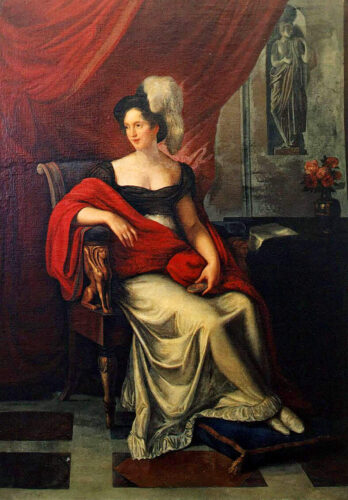Lucia Migliaccio Duchess of Floridia
Biography of Lucia Migliaccio Duchess of Floridia, second wife of King Ferdinand IV of Bourbon, and "failed" queen because of lower rank
The origins of Lucia Migliaccio Duchess of Floridia
Lucia Migliaccio Duchess of Floridia (Syracuse, 18 January 1770 – Naples, 26 April 1826)
Lucia Migliaccio, Sicilian of colors and perfumes, became queen without ever having hoped for it. She was from Syracuse, she was born in 1770, on January 18, to Vincenzo, Duke of Floridia, and Dorotea Borgia of the Marquises of Casale. A family, that of the Migliaccios of Sicily, which had its roots in the fifteenth-century cavalry of the island.
The meeting with the King
He met Ferdinand IV in his first Palermitan exile, when with the arrival of the French in Naples and the birth of the Neapolitan Republic in 1799, the monarchy experienced the first attacks of modern times; she was married to Benedetto Grifeo and Del Bosco, duke of Ciminna and prince of Partanna. They met again in 1806, when the royal family had found refuge in Palermo due to the arrival of Giuseppe Bonaparte in the capital. She and she was a widow. The Bourbons followed the fate of the Kingdom from the island, but the king did not seem to give too much weight to the question if he did not lose any of his lifestyle habits, first of all hunting and then his passion for women. Thus was born, slowly but surely, a love story that proved fatal.
The love story with the King
Ferdinand married her in 1814, two months after Maria Carolina’s death. They had chosen themselves this time. No political strategy, no alliance. It was a morganatic wedding. Lucia belonged to a lower-ranking nobility, she could never have aspired to the throne and if children were born from their union they would not have had the right to the dynastic succession, nor to the inheritance of the patrimony. This was not enough to make her loved in the family. Of all the children of Ferdinando and Maria Carolina, the one who most opposed the new marriage was Francesco who never accepted the choice of his father, who never loved Lucia.
Life as a "missed" Queen
In May 1815 Lucia arrived in Naples for the first time. Her minute body, her short step, her Mediterranean being in her colors, in her smile, in her bearing, made her well liked by people who did not see in her someone different from themselves. During the ten years of marriage Ferdinando showered her with endearments and gifts. Not only duchies and jewels but two beautiful residences: the noble palace in Piazza dei Martiri, in the Chiaia district, which has since been called Palazzo Partanna, and the large villa on the hill, in the nascent Vomero district, which also had a zoo and which today , which has become a public park, is called “La Floridiana”.
The end
Ferdinando died, at the age of seventy, on January 4, 1825. The pain that accompanied Lucia’s life from that day on was strong. She was alone now, really. She died seriously ill on April 26, 1826. She was 56 years old. She was buried in the city that saw her happy, in the church of San Ferdinando, a stone’s throw from the royal palace. A neoclassical-style tomb was erected for her, based on a project by Tito Angelini.


